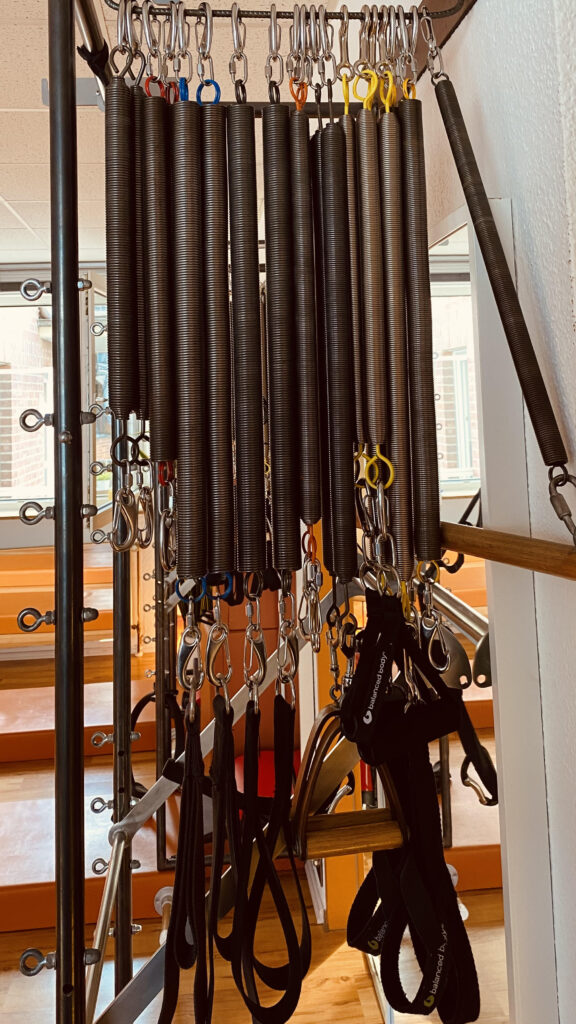Issue #350 – Wednesday, November 3, 2021
Let’s Talk Springs
by Reiner Grootenhuis
For us Pilates apparatus fans, springs are an essential part of the method. For each exercise and client, we try to choose the best spring setting for the body in front of us. Depending on the apparatus, this entails choosing the strength of the springs and the number of springs along with (on the Cadillac, for example) the height of the spring attachment and the client’s distance to the hooks. Everything matters and every choice changes the outcome of the exercise. In contrast to what some beginners may believe, more is not always better and less might be much better.
As experienced Pilates teachers, we know the springs we use in our daily work inside and out. We carefully read our clients’ reactions to the spring settings and quickly readjust if we feel the necessity. For teachers just starting out, this can become overwhelming. Where are the green zones and where are the “no go” areas?
When Pamela Pardi, a former client of Carola Trier, told Carola that she had become a Pilates teacher working for Romana Kryzanowska, Carola said:
You are not a teacher. You are a lighthouse, and you steer the ships – which are the customers – away from the rocks.
After having been in the Pilates “coast guard business” for some years, you might reach a point where you ask yourself (or read in some Pilates groups on Facebook), “Are the springs I use day to day the best springs I could use, or are there perhaps better or even magical springs?” And with this question, you can go down a rabbit hole. Let me be your Cheshire Cat. 
No one really knows how Joseph Pilates’ springs felt, and even if we had access to his original springs, we wouldn’t know what age and usage might have done to them. From what the Elders tell us, the Reformer springs in Joseph Pilates’ studio weren’t all the same. Was this on purpose or only because spring production in his time wasn’t able to produce constant results? Even today, this seems to still be partly true as the same springs from some companies vary quite a bit – sometimes it’s necessary to at least order four springs to get a truly matching pair.
Tip: You can soften a spring by overextending it a bit, but be careful as the effect is irreversible. Some apparatus companies use this technique to pair springs.
On your new path to spring magic, your starting point is very individual. Do you mainly own traditional equipment or modern equipment? Perhaps it is called traditional equipment but while the dimensions are “correct”, the springs are strange? In any case, here are some possible routes to try out.
- Deborah Lessen Reformer/Trapeze Table Springs. Yes, it is the same spring for a Push-Through-Bar and for the Reformer. The spring is extra heavy at the beginning of the movement and becomes softer in the middle. Especially on a modern Reformer with ball bearings (please see my article about the differences between ball and plain bearings on Reformers https://pilates-powers.de/pilates-blog/2017/11/26/reformer-rolling-resistance), the Deborah Lessen Reformer/Trapeze Table Springs offer some starting resistance. On most Balanced Body Reformers, there will be an inch of slack between the stopper and the end of the spring tension. You must move the carriage home just by your own muscles – a great challenge.
- Gratz springs. Gratz is often considered to be one of the most traditional producers since Romana Kryzanowska worked with them starting in the 1970’s and recommended them. While unfortunately pairing is not their strong suit and lead times are often long, all their springs reflect to a certain extent the true meaning of our method. I can highly recommend starting with any pair of springs and work your way through. From the Arm Chair springs, which you can get separately, to their normal Arm Springs, everything makes sense and informs your body. In my opinion, Pilates Design springs and Gratz springs are interchangeable and you can order by your brand preference.
- Pilates Scandinavia. Frederik Prag’s Arm, Leg and Roll-Down springs are Gratz on steroids. They are perfect for those male clients who need the extra “oomph”. While using them, the soft zone is shorter, and you start to feel the beastly power of their springs right towards the end where one is typically the weakest.

- Balanced Body CenterLine® Reformer Non-Plated Springs. According to Balanced Body, the CenterLine Reformer springs are semi-heavy springs. Testing them, they look very similar to the green Reformer springs, but are actually quite different. They have a certain feel to them which is just wonderful. I retrofitted my Peak wooden Reformer (with high resistance wheels, which is nothing more than plain bearings) and my customers love them. Worth a try.
- Balanced Body Trapeze long springs 31″ (79cm) in yellow (very light). They are ideal to do some more extended leg/hip work as you might have seen from Gyro fans. If you get them, do not forget to either order the Balanced Body Y-loops or have a look at the Elements by Momentum World website. They offer them in different sizes for a snug fit.
Personally, I have a wide collection of springs (Peak, Techno Pilates, Pilates Lineage, Arregon … and many more), and have only mentioned the ones at the very top of my mind here. If I haven’t mentioned your favorite spring brand, do let me know. I love learning what others appreciate in Pilates equipment that I may not have noticed so far.
I truly hope the recommendations give you some ideas to consider and maybe you know of a Pilates studio where you can test them before buying. A visit of a fellow Pilates enthusiast is always welcome in my studio! Enjoy your new spring magic!

He completed his training as a Pilates instructor for Pilates mat and equipment at the Pilates educational academy Body Arts & Science International. Reiner has founded a free-of-charge immensely successful pilates-contrology-marketplace for selling and buying Pilates equipment on Facebook, which has almost 18,000 members.

